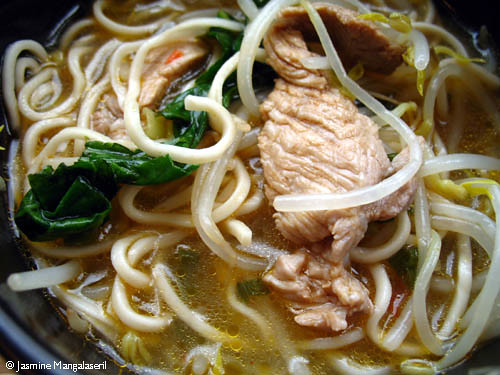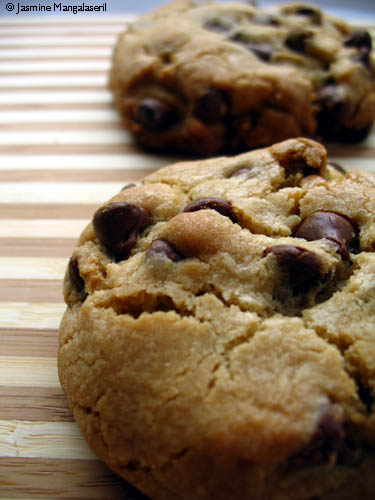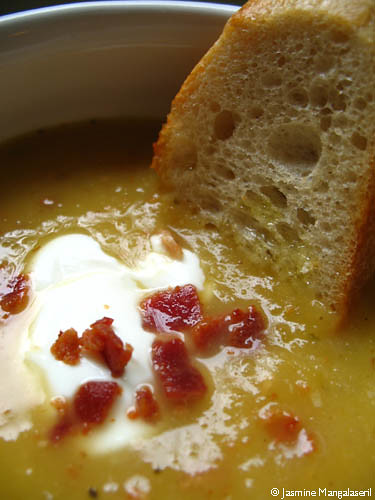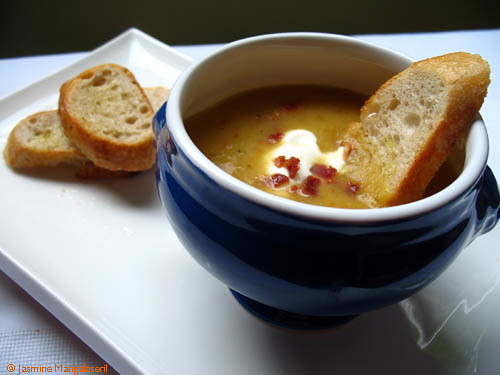 Kitchen
KitchenBy Nigella Lawson
Alfred A. Knopf/Random House Canada
512 pages; $55
There’s a small number of authors whose new works I eagerly await: AS Byatt, Christopher Brookmyre, Stephen Fry, Nigella Lawson and Nigel Slater. Their words are smart, engaging so incredibly well honed. When I grow up I want to write like that.
When I peruse a cookbook, I skim it for more than just recipes. Without a doubt the recipes must make me want to lock myself into my kitchen and lose myself in chopping, drizzling, frizzling and sampling. Just as important is how the author coaxes me into keeping that book in my hands. I want the author to talk to me as a friend and be someone I’d invite into my kitchen. I don’t want to be talked down to, lectured to by someone with self-fashioned airs of superiority.
Nigella Lawson brings her brand of combined eloquence and common sense cookery in her new offering, Kitchen. In it, she continues her particular type of food diarisation—her first book How To Eat features a section on nursery foods and feeding very young children, others included foods palatable to younger mouths—this time as a busy working mum with equally busy teenagers.
Her recipes, as usual, range from combining simple ingredients into quick and tasty meals such as Egg and Bacon Salad to longer cooked meals such as Beer-braised Pork Knuckles with Caraway, Garlic, Apples and Potatoes. She also brings in disparate foodish inspirations from areas such as Spain, Vietnam, South Africa and Italy. The instructions are clear and easy to follow and usually accompanied by lovely photographs. Many recipes include tips about freezing, how to use leftovers and make-ahead notes.
As with her other Canadian imprints, the text appears to be the same as in the original British imprint, which means she uses weight metrics and not volume. This may be an issue for many North American cooks, but since a digital kitchen scale can be bought for the price of a couple of bottles of extra virgin olive oil, this shouldn’t be that much of an issue.
What some readers may find useful are two early sections: “Kitchen Caboodle” and “Kitchen Confidential”—the first is what’s known in some books as “batterie de cuisine,” a listing of kitchen equipment the author finds essential. What’s equally useful is her “Hall of Shame” section that lists regrettable purchases she’s made (ahem, including the slow cooker). Such lists are, of course, highly individual and should be taken with a grain of salt. Kitchen Confidential compiles her various kitchen tips on ingredients such as baking powder, sea salt and vermouth to tools and gadgets such as pastry brushes and disposable rubbery gloves and tips on baking and frying.
As with my other reviews, the proof of a book’s value is in the recipes. Here are the ones I attempted:
 Vietnamese Pork Noodle Soup (p82)
Vietnamese Pork Noodle Soup (p82)I really like pho, but find their quantity overwhelming when at restaurants. Nigella’s version had fresh and bright flavours and it was very warming. As with any home cooked food, I can control my portion, but here I thought the noodle quantity was two to three times what I think it should have been or the amount of broth should be increased. Easily resolved the next time I make this.
 Spanish chicken with chorizo and potatoes (p100)
Spanish chicken with chorizo and potatoes (p100)Delicious. Spicy sausage and roast chicken with just a hint of orange. I was so happy with this meal that I’ve since replicated it with other types of sausage and seasonings. It’s more than easy and (as you can tell from the picture) a doddle to decrease to feed one person (as opposed to six).
 Chocolate Chip Cookies (p236)
Chocolate Chip Cookies (p236)Everyone has their own idea as to what makes a good chocolate chip cookie and this was definitely not mine. I prefer thin, buttery discs which are crispy around the edges and chewy in the centre. I also like them to be of a reasonable size (say 2” or 5cm in diameter). Hers are cakey and are dolloped in ¼ cup measurements. I would have used a teaspoon or a tablespoon at most.
 Sweet Potato Supper (p340)
Sweet Potato Supper (p340)This dish combines three of my favourite ingredients—asparagus, bacon and sweet potatoes—in an incredibly simply way. I loved the way the salty, smoky bacon played against the lush sweet potatoes and slightly caramelised asparagus.
So how does it rate?
Overall: 3.8/5
The breakdown:
Recipe Selection: 4/5
Writing: 4.5/5
Ease of use: 3/5
Yum factor: 4/5
Table-top test: Lies flat
Kitchen comfort-level: Easy-Intermediate
Pro: A good range of recipes ranging drawn from a number of cuisines.
Con: Based on the pho and cookies, some on-the-fly corrections may be needed.


